**Morinda citrifolia (noni)**
@steemingit40 @voting @trending
Morinda citrifolia is a tree in the coffee family, Rubiaceae. Its nativerange is extended through Southeast Asia and Australasia, and the speciesare now cultivated throughout the tropics and is widely naturalized.
**scientific classifications **
Kingdom: Plantae
Clade: Angiosperms
Clade: Eudicots
Clade: Asterids
Order: Gentianales
Family: Rubiaceae
Genus: Morinda
Species: M. citrifolia
Binomial name
Morinda citrifolia
There are 100 names for the fruit across different regions are the more common English names, great morinda, Indian mulberry, noni, beach mulberry, and cheese fruit.
Growing habitats
Morinda citrifolia grows in shady forests, as well as on open rocky or sandy shores. It reaches it's maturity in about 18 months, then yields between 4 and 8 kg (8.8 and 17.6 lb) of fruit every month throughout the year. It is mostly tolerant of saline soils, drought conditions, and secondary soils. It is therefore found in a wide variety of habitats: volcanic terrains, lava-strewn coasts, and limestone outcrops, as well as in coralline atolls. It can grow up to a height of 9 m (30 ft) tall, and has large, simple, dark green, shiny and deeply veined leaves.
The plant bears flowers and fruits through out the year. The fruit is a multiple fruit that has a pungent odour when ripening, and is also known as the cheese fruit or vomit fruit. It has an oval shape and reaches 10–18 centimetres (3.9–7.1 in) size. At first green, the n the fruit turns yellow and then almost white as it ripens. It contains lot of seeds.
Morinda citrifolia is highly attractive to weaver ants, which make its nests from the leaves of the tree.These ants protect the plant from some plant-parasitic insects. The smell of the fruit attracts fruit bats, which aid in the dispersing the seeds. A type of fruit fly called Drosophila sechellia, feeds exclusively on these fruits.
Food
A variety of beverages (juice drinks), powders (from the dried ripe or unripe fruits), cosmetic products (lotions, soaps), oil (from tge seeds), leaf powders (for encapsulation or pills) have been introduced into consumer market.
Noni is sometimes called the starvation fruit. Despite its strong smell and bitter taste, the fruit is eaten as a famine food and, in some parts of Pacific islands, even a staple food, either raw or cooked.Southeast Asians and Australian Aborigines eat the fruit raw with salt or cook it with curry. The seeds are also edible when roasted.
In Thai cuisine, the leaves (known as bai-yo) are used as a green vegetable and are mostly the main ingredient of kaeng bai yo in which the leaves are cooked with coconut milk. The fruit (luk-yo) is also added as a salad ingredient to some versions of somtam.
**Traditional medicine **
Green fruit, leaves, and root/rhizomes might have been used in Polynesian cultures as a general tonic, in addition to its traditional place in Polynesian culture as a famine food.
In traditional Chinese medicine, the roots, known as ba ji tian, have been usedto solve abdominal pain, impotence, and menstrual disorders. Although Morinda is considered to have high biological properties in traditional medicine, there is no confirmed evidence of clinical efficacy for any intended usage.
**Dyes **
Morinda bark produces a brownish-purplish dye that is used for making batik. In Hawaii, yellowish dye is also extracted from its roots to dye cloth.
Nutrients and phytochemicals
Morinda citrifolia fruit powder contains carbohydrates and dietary fibre in high moderate amounts. These macronutrients evidently reside in the fruit pulp, as M. citrifolia juice has sparse nutrient content.The main micronutrients of M. citrifolia pulp powder include vitamin C, niacin (vitamin B3), iron and potassium. Vitamin A, calcium and sodium are present in high moderate amounts. When M. citrifolia juice alone is analyzed and compared to pulp powder, only vitamin C is retained in an of amount (34 mg per 100 gram juice) that is 64% of the content of the raw navel orange (53 mg per 100 g or 89% of the Daily Value). Sodium levels in M. citrifolia juice (about 3% of Dietary Reference Intake, DRI) are high compared to an orange, and potassium content is moderate.
Morinda citrifolia fruit contains a great number of phytochemicals, including lignans, oligo- and polysaccharides, flavonoids, iridoids, fatty acids, scopoletin, catechin, beta-sitosterol, damnacanthal, and alkaloids. Although these substances have been studied for bioactivity, current research is insufficient to conclude anything about their effects on human health. These phytochemicals are not unique to M. citrifolia, as they exist in various plants.
**Gallery **
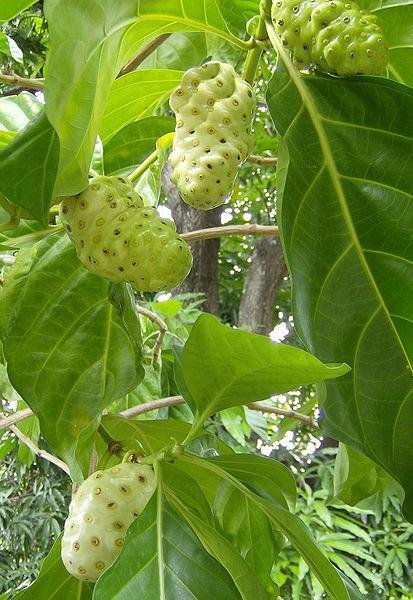
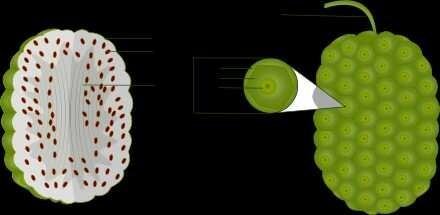
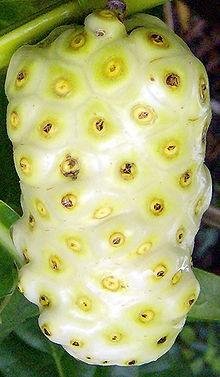
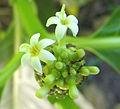
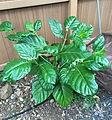
Phobia triggered. O. O
Have never seen anything like it before! thank you for sharing :)
This was very interesting and informative.
cheese fruit : )